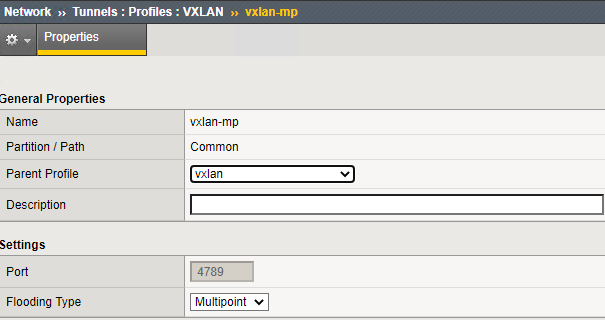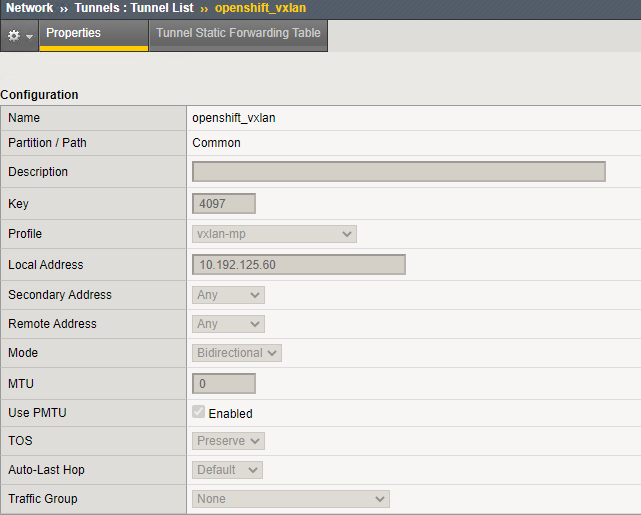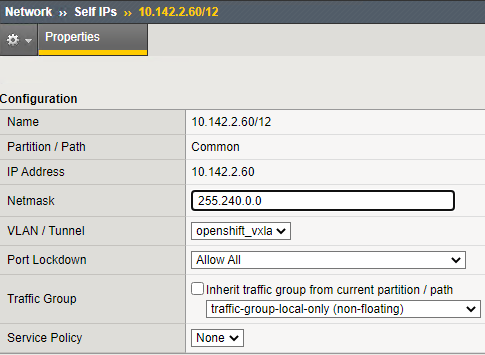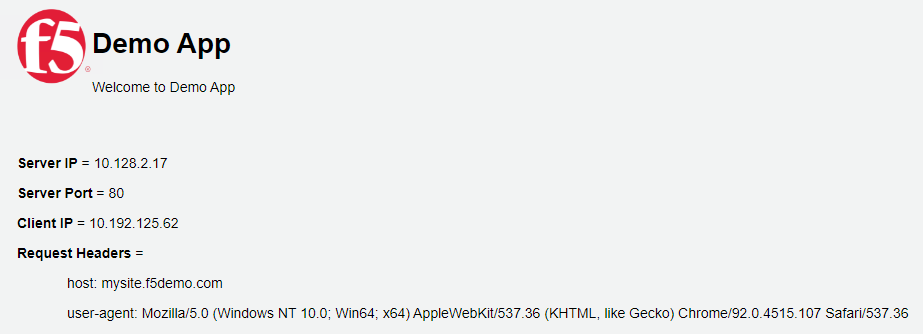OpenShift 4.8 and F5 BIG-IP Container Ingress Services (CIS) User-Guide for Standalone BIG-IP using OVN-Kubernetes Advanced Networking¶
Note
OVN-Kubernetes hybrid overlay iCNIv1 feature has been removed from Openshift v4.13+, hence we recommend using OVN-Kubernetes with static routes. For more information, see OVN hybridOverlay ICNIv1 feature on Openshift.
This user guide is create to document OpenShift 4.8 integration of CIS and standalone BIG-IP using OVN-Kubernetes advanced networking. This user guide provides configuration for a standalone BIG-IP with OVN-Kubernetes hybrid overlay feature(VxLAN). OVN-Kubernetes hybrid overlay uses the GENEVE protocol for EAST/WEST traffic within the OpenShift Cluster and VxLAN tunnels to network BIG-IP devices.

Configuration Steps¶
You can watch a demonstration of these steps in this video:
RedHat documents the installation of OVN-K8S advanced networking in the specifying advanced network configuration sections of the install process. Based on the following note from RedHat, its very important to follow the installation of OVN-Kubernetes Hybrid Overlay Feature when installing OpenShift. Modification, migration cannot be applied once OpenShift is already installed.

Prerequisites¶
You have created the install-config.yaml file with the required modifications. When creating the install-config.yaml, change the default networkType: OpenShiftSDN to networkType: OVNKubernetes.
Step 1: Create install-config.yaml¶
Create install-config.yaml:
# ./openshift-install create install-config --dir=ipi
? Platform vsphere
? vCenter vcsa7-pme.f5demo.com
? Username administrator@f5demo.com
? Password [? for help] *********
INFO Connecting to vCenter vcsa7-pme.f5demo.com
? Datacenter PME-LAB
? Cluster OCP-PM
? Default Datastore datastore1 (3)
? Network VM Network
? Virtual IP Address for API 10.192.125.101
? Virtual IP Address for Ingress 10.192.125.102
? Base Domain f5demo.com
? Cluster Name ocp-pm
? Pull Secret [? for help] ......
INFO Install-Config created in: ipi
1 2 3 4 5 6 7 8 9 10 11 12 13 14 15 16 17 18 19 20 21 22 23 24 25 26 27 28 29 30 31 32 33 34 35 36 37 38 39 40 41 | # cat install-config.yaml apiVersion: v1 baseDomain: f5demo.com compute: - architecture: amd64 hyperthreading: Enabled name: worker platform: {} replicas: 3 controlPlane: architecture: amd64 hyperthreading: Enabled name: master platform: {} replicas: 3 metadata: creationTimestamp: null name: ocp-pm networking: clusterNetwork: - cidr: 10.128.0.0/14 hostPrefix: 23 machineNetwork: - cidr: 10.0.0.0/16 networkType: OVNKubernetes serviceNetwork: - 172.30.0.0/16 platform: vsphere: apiVIP: 10.192.125.101 cluster: OCP-PM datacenter: PME-LAB defaultDatastore: datastore1 (3) ingressVIP: 10.192.125.102 network: VM Network password: secret username: administrator@f5demo.com vCenter: vcsa7-pme.f5demo.com publish: External pullSecret: removed # |
Step 2: Create manifests¶
# ./openshift-install create manifests --dir=ipi
INFO Consuming Install Config from target directory
INFO Manifests created in: ipi/manifests and ipi/openshift
# ls
04-openshift-machine-config-operator.yaml cluster-infrastructure-02-config.yml cluster-proxy-01-config.yaml kube-system-configmap-root-ca.yaml
cloud-provider-config.yaml cluster-ingress-02-config.yml cluster-scheduler-02-config.yml machine-config-server-tls-secret.yaml
cluster-config.yaml cluster-network-01-crd.yml cvo-overrides.yaml openshift-config-secret-pull-secret.yaml
cluster-dns-02-config.yml cluster-network-02-config.yml kube-cloud-config.yaml openshift-kubevirt-infra-namespace.yaml
Step 3: Copy cluster-network-03-config.yaml to manifests directory¶
See also
RedHat documentation for Configuring hybrid networking with OVN-Kubernetes
Create a stub manifest file for the advanced network configuration that is named cluster-network-03-config.yml in the <installation_directory>/manifests/ directory. The defaultNetwork: hybridOverlayConfig: {} is required.
# cat cluster-network-03-config.yaml
apiVersion: operator.openshift.io/v1
kind: Network
metadata:
name: cluster
spec:
clusterNetwork:
- cidr: 10.128.0.0/14
hostPrefix: 23
serviceNetwork:
- 172.30.0.0/16
defaultNetwork:
ovnKubernetesConfig:
hybridOverlayConfig: {}
type: OVNKubernetes
# cp cluster-network-03-config.yaml /openshift/ipi/manifests/
1 2 3 4 5 6 7 8 9 10 11 12 13 14 | apiVersion: operator.openshift.io/v1 kind: Network metadata: name: cluster spec: clusterNetwork: - cidr: 10.128.0.0/14 hostPrefix: 23 serviceNetwork: - 172.30.0.0/16 defaultNetwork: ovnKubernetesConfig: hybridOverlayConfig: {} type: OVNKubernetes |
Step 4: Create Cluster¶
Create the OpenShift cluster:
# ./openshift-install create cluster --dir=ipi
INFO Consuming Worker Machines from target directory
INFO Consuming OpenShift Install (Manifests) from target directory
INFO Consuming Openshift Manifests from target directory
INFO Consuming Master Machines from target directory
INFO Consuming Common Manifests from target directory
INFO Creating infrastructure resources...
INFO Waiting up to 20m0s for the Kubernetes API at https://api.ocp-pm.f5demo.com:6443...
INFO API v1.21.1+8268f88 up
INFO Waiting up to 30m0s for bootstrapping to complete...
INFO Destroying the bootstrap resources...
INFO Waiting up to 40m0s for the cluster at https://api.ocp-pm.f5demo.com:6443 to initialize...
INFO Waiting up to 10m0s for the openshift-console route to be created...
INFO Install complete!
INFO To access the cluster as the system:admin user when using 'oc', run 'export KUBECONFIG=/openshift/ipi/auth/kubeconfig'
INFO Access the OpenShift web-console here: https://console-openshift-console.apps.ocp-pm.f5demo.com
INFO Login to the console with user: "kubeadmin", and password: "secret"
INFO Time elapsed: 26m50s
#
Step 5: Validate¶
Validate defaultNetwork: hybridOverlayConfig was configured correctly during OpenShift installation:
# oc --kubeconfig /openshift/ipi/auth/kubeconfig get networks.operator.openshift.io cluster -o yaml
apiVersion: operator.openshift.io/v1
kind: Network
metadata:
annotations:
networkoperator.openshift.io/ovn-cluster-initiator: 10.192.125.160
creationTimestamp: "2021-08-03T06:50:15Z"
generation: 53
name: cluster
resourceVersion: "22347"
uid: 8942ef7d-31e7-4dde-8873-685d9231b891
spec:
clusterNetwork:
- cidr: 10.128.0.0/14
hostPrefix: 23
defaultNetwork:
ovnKubernetesConfig:
genevePort: 6081
hybridOverlayConfig: {} --- Shows the correct configuration for hybrid networking
mtu: 1400
policyAuditConfig:
destination: "null"
maxFileSize: 50
rateLimit: 20
syslogFacility: local0
type: OVNKubernetes
deployKubeProxy: false
disableMultiNetwork: false
disableNetworkDiagnostics: false
logLevel: Normal
managementState: Managed
observedConfig: null
operatorLogLevel: Normal
serviceNetwork:
- 172.30.0.0/16
unsupportedConfigOverrides: null
useMultiNetworkPolicy: false
Create a BIG-IP VXLAN tunnel for OVN-Kubernetes Advanced Networking¶
Step 1: Create the tunnel profile¶
(tmos)# create net tunnels vxlan vxlan-mp flooding-type multipoint

(tmos)# create net tunnels tunnel openshift_vxlan key 4097 profile vxlan-mp local-address 10.192.125.60
Note
OpenShift uses 4097(VNI) for VxLAN communication.

Step 2: Create Self IP for CNI¶
(tmos)# create net self 10.142.2.60/12 allow-service all vlan openshift_vxlan
Note
Use the self IP range (10.142.2.60/12) which supernets the OpenShift cluster network (i.e. 10.128.0.0/14) to differentiate the VxLAN and GENEVE communication.

Diagram of all the BIG-IP self IP addresses:

Create a partition on BIG-IP for CIS to manage¶
(tmos)# create auth partition OpenShift
Note
This needs to match the partition in the controller configuration created by the CIS Operator.
Create CIS Controller, BIG-IP credentials, and RBAC Authentication¶
Since CIS is using the AS3 declarative API, you need the AS3 extension installed on BIG-IP. Follow the link to install AS3.
Create f5-bigip-deployment manifests:
# oc create secret generic bigip-login --namespace kube-system --from-literal=username=admin --from-literal=password=<secret> # oc create serviceaccount bigip-ctlr -n kube-system # oc create -f f5-openshift-clusterrole.yaml # oc create -f f5-bigip-deployment.yaml # oc adm policy add-cluster-role-to-user cluster-admin -z bigip-ctlr -n kube-system
Add OVN-Kubernetes advanced networking CNI specific annotations¶
You need to add OVN-Kubernetes advanced networking CNI specific annotations to all namespace that CIS is monitoring and configuring on BIG-IP. This user guide uses the namespace default.
apiVersion: v1
kind: Namespace
metadata:
name: default
annotations:
k8s.ovn.org/hybrid-overlay-external-gw: 10.142.6.60 #self ip of Vxlan tunnel
k8s.ovn.org/hybrid-overlay-vtep: 10.192.125.62 #BIG-IP interface address rotatable to the OpenShift nodes
# oc apply -f ocp-exgw.yaml
1 2 3 4 5 6 7 | apiVersion: v1 kind: Namespace metadata: name: default annotations: k8s.ovn.org/hybrid-overlay-external-gw: 10.142.2.60 #self ip of Vxlan tunnel k8s.ovn.org/hybrid-overlay-vtep: 10.192.125.60 #BIG-IP interface address rotatable to the OpenShift nodes |
Installing the Demo App in OpenShift and validate the OVN-Kubernetes advanced networking annotations¶
Deploy demo app in OpenShift:
# oc create -f demo-app/Validate deployed demo apps in OpenShift:
# oc get pod NAME READY STATUS RESTARTS AGE f5-demo-9498f95fc-5fnj5 1/1 Running 0 34s f5-demo-9498f95fc-62g4l 1/1 Running 0 34s f5-demo-9498f95fc-qdl8b 1/1 Running 0 34s f5-demo-9498f95fc-zswjd 1/1 Running 0 34s
Validate OVN-Kubernetes advanced networking annotations applied to the deployed application pod. As you can see below, the deployed pod has added annotations for k8s.ovn.org/hybrid-overlay-external-gw: 10.142.2.60 using the BIG-IP vtep k8s.ovn.org/hybrid-overlay-vtep: 10.192.125.60.
# oc describe pod f5-demo-9498f95fc-5fnj5 Name: f5-demo-9498f95fc-5fnj5 Namespace: default Priority: 0 Node: ocp-pm-2zxp2-worker-9bn9s/10.192.125.165 Start Time: Tue, 03 Aug 2021 00:27:45 -0700 Labels: app=f5-demo pod-template-hash=9498f95fc Annotations: k8s.ovn.org/hybrid-overlay-external-gw: 10.142.2.60 k8s.ovn.org/hybrid-overlay-vtep: 10.192.125.60 k8s.ovn.org/pod-networks: {"default":{"ip_addresses":["10.128.2.18/23"],"mac_address":"0a:58:0a:80:02:12","gateway_ips":["10.128.2.3"],"routes":[{"dest":"10.128.0.0... k8s.v1.cni.cncf.io/network-status: [{ "name": "ovn-kubernetes", "interface": "eth0", "ips": [ "10.128.2.18" ], "mac": "0a:58:0a:80:02:12", "default": true, "dns": {} }] k8s.v1.cni.cncf.io/networks-status: [{ "name": "ovn-kubernetes", "interface": "eth0", "ips": [ "10.128.2.18" ], "mac": "0a:58:0a:80:02:12", "default": true, "dns": {} }] Status: Running IP: 10.128.2.18 IPs: IP: 10.128.2.18 Controlled By: ReplicaSet/f5-demo-9498f95fc Containers: f5-demo: Container ID: cri-o://51c6fff708dca44b5448f6604b3aff0ae8da3d98c3bead99a4b4098ed52902c7 Image: f5devcentral/f5-demo-httpd Image ID: docker.io/f5devcentral/f5-demo-httpd@sha256:1c86ba346fa766356365f2f05bc3be6c2cdd5eb69552ce3867091c9a38d6ee2b Port: 80/TCP Host Port: 0/TCP State: Running Started: Tue, 03 Aug 2021 00:27:56 -0700 Ready: True Restart Count: 0 Environment: service_name: f5-demo Mounts: /var/run/secrets/kubernetes.io/serviceaccount from kube-api-access-rmggv (ro) Conditions: Type Status Initialized True Ready True ContainersReady True PodScheduled True Volumes: kube-api-access-rmggv: Type: Projected (a volume that contains injected data from multiple sources) TokenExpirationSeconds: 3607 ConfigMapName: kube-root-ca.crt ConfigMapOptional: <nil> DownwardAPI: true ConfigMapName: openshift-service-ca.crt ConfigMapOptional: <nil> QoS Class: BestEffort Node-Selectors: <none> Tolerations: node.kubernetes.io/not-ready:NoExecute op=Exists for 300s node.kubernetes.io/unreachable:NoExecute op=Exists for 300s Events: Type Reason Age From Message ---- ------ ---- ---- ------- Normal Scheduled 48s default-scheduler Successfully assigned default/f5-demo-9498f95fc-5fnj5 to ocp-pm-2zxp2-worker-9bn9s Normal AddedInterface 46s multus Add eth0 [10.128.2.18/23] from ovn-kubernetes Normal Pulling 46s kubelet Pulling image "f5devcentral/f5-demo-httpd" Normal Pulled 39s kubelet Successfully pulled image "f5devcentral/f5-demo-httpd" in 7.503713793s Normal Created 38s kubelet Created container f5-demo Normal Started 38s kubelet Started container f5-demo #
Create Route for Ingress traffic to Demo App¶
Create a basic route for Ingress traffic from BIG-IP to Demo App:
# oc create -f f5-demo-route-basic.yamlValidate the route via the OpenShift UI under the Networking/Routes:

Validate the route via the BIG-IP:

Note
To provide feedback on Container Ingress Services or this documentation, please file a GitHub Issue.